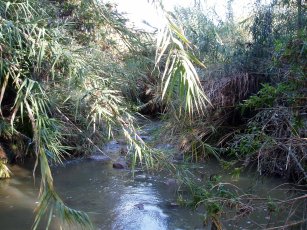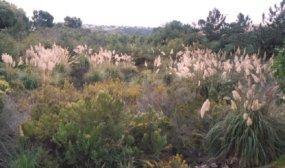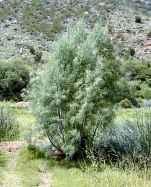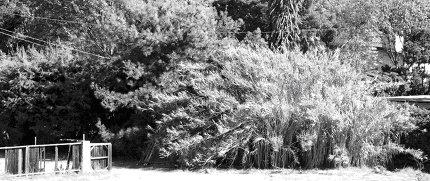The Invasives Problem
Most Problematic Invasives
Invasives Removal Project
Invasives Removal Project Contacts
Invasive Brochures
The Invasives Problem
Invasive exotic plants have colonized large areas of many of these watersheds and have significantly degraded their essential functions and beneficial uses. Extensive stands of invasive exotic plant species alter the riparian/wetland trophic structure, organic loading, nutrient spiraling, dissolved organic matrix, biogeochemistry, contaminant complexation, evapotranspiration, turbidity, avian and aquatic species composition and abundance, and the ability of the habitat to support rare and endangered species. (Faber et al. 1989).
WATERSHED |
ACRES |
Agua Hedionda & Buena Creeks |
43 |
Buena Vista Creek |
28 |
Encinas Creek |
28 |
Escondido Creek |
97 |
Loma Alta Creek |
14 |
San Marcos Creek |
70 |
 The density, biomass, and diversity of invasive plant species is so
extensive in the watersheds of the CHU that the ability of natural plant
communities to treat nutrient and contaminant loading is being significantly
reduced, and internal generation/loading and recycling (spiraling)
of nutrients is substantial and eutrophic. Tto the right is an example of Arundo completely taking over a portion of Escondido Creek and totally displacing native plants and destroying the natural habitat.
The density, biomass, and diversity of invasive plant species is so
extensive in the watersheds of the CHU that the ability of natural plant
communities to treat nutrient and contaminant loading is being significantly
reduced, and internal generation/loading and recycling (spiraling)
of nutrients is substantial and eutrophic. Tto the right is an example of Arundo completely taking over a portion of Escondido Creek and totally displacing native plants and destroying the natural habitat.
In addition to invasive macrophytes, seasonal aquatic algal growth densely
covers hard substrates and exacerbates nutrient loading. Natural riparian/wetlands
habitats improve water quality by removing excess nutrients and chemical
contaminants (National Research Council 1992).  We surmise that the dissolved and particulate aquatic organic matrix
has changed and altered the natural assimilative capacity in complex
ways. Removal of the primary cause of the altered internal recycling
and organic matrix (i.e. invasive plants) will help to restore natural
water quality treatment processes (Welch and Lindell 1980).
We surmise that the dissolved and particulate aquatic organic matrix
has changed and altered the natural assimilative capacity in complex
ways. Removal of the primary cause of the altered internal recycling
and organic matrix (i.e. invasive plants) will help to restore natural
water quality treatment processes (Welch and Lindell 1980).
According to the draft Watershed Management Chapter of the San Diego Regional
Water Quality Control Board (SDRWQCB), significant adverse environmental
effects of two of the most extensive exotic species in the CHU, giant
reed (Arundo donax) and salt cedar (Tamarix sp.), include:

- dramatic reductions in wildlife habitat values and functions;
- increases in flooding due to increased flow obstruction;
- reductions in dry season base flows within streams due to extensive increases in evapotranspiration water losses;
- reductions in recreational uses due to physical restrictions to passage, reduced recreational and habitat values, and reduced areas of open water.
Giant reed converts the infected river's hydrologic regime from one that is flood dominated, to one that is fire dominated. Salt cedar has the additional impact of creating saline soils.
Most Problematic Invasives (See Invasives List)
All watersheds suffer invasion by significant amounts of Arundo, Pampas Grass, Tamarisk and Palms with substantial amounts of Artichoke thistle, German Ivy, and Withetop.
INVASIVE |
ACRES |
Artichoke thistle |
3.1 |
Arundo |
90.2 |
Brazilian pepper |
0.6 |
Castor bean |
0.7 |
Eucalyptus |
0.2 |
General |
2.8 |
German ivy |
1.4 |
Myoporum |
0.4 |
Palms |
18.5 |
Pampas grass |
142.1 |
Tamarisk |
14.8 |
Vinca |
0.3 |
Whitetop |
4.0 |
Below are the most destructive and problematic invasive plants. See the full list of invasives for a listing of these invasive plant, their latin name, and information about the problems each invasive causes.
| giant reed (Arundo donax) Fast growing invasive. This is not a bamboo. See full color brochure on this invader. | |
 |
pampas grass (Cortaderia sp.), Besides its invasive character, the stems can cut your fingers. See full color brochure on this invader. |
| castor bean (Ricinus communis). Myoporum
laetum, This non native is poisonous. See full color brochue on this poisonous invasive. |
|

|
salt cedar (Tamarix sp.), |
Some of these invasives exacerbate problems in uplands in the CHU, contributing to watershed degradation. All of the species listed above are on the California Invasive Plant Council's A-1 List of widespread invasive pest plants. To learn more about invasives, visit the California Invasives Plant Council site.
The future consequences of accumulated fire fuel, flood debris jams, worsening
Category 1 impaired water quality conditions, and loss of native riparian/wetland
biodiversity is serious.
Invasives Removal Project
The Dr. Alan Thum Invasives Removal Project targeting the most heavily infected stream and watersheds of the Carlsbad Hydrologic Unit is funded by a State of California Prop 13 grant to remove the most threatening invasive plant species (i.e. arundo, tamarix, pampas grass, and palms) from over 250 acres of the CHU.
This project proposes a major effort to remove the predominant species of invasive plants and to restore native vegetation in these watersheds as an essential step in reestablishing the hydrologic and ecological functions of these riparian and coastal wetland habitats.

Preliminary estimates of acreages needing clearing include 142 acres of pampas grass (Cortaderia sp.), 90 acres of giant reed ( Arundo donax ), 18 acres of palms, 14 acres of salt cedar (Tamarix sp.), and other invasives at lower coverages, totaling 278 acres.
As part of the invasive species control project, we have mapped the invasive species within the CHU using Geographic Information Systems (GIS). GIS users who are interested in downloading the invasives shapefile can do so by clicking here.
You can help by:
- Permit the Invasives Removal Project staff to remove these invasive plants when asked for permission.
- Removing these invasive plants from your property. See Invasive Brochures and Invasive Removal for information on how to rid yourself of these plants. See NIIMBY for an overview of our outreach to encourage individual action.
- Encouraging your friends, family and neighbors to destroy and remove invasives from their property. Send an email encouraging them to visit this site and learn more about the environmental destruction being caused by invasive plants.
Invasives Removal Project Contacts
Project Director: Doug Gibson, 760-436-3944
Field Coordinator:, Amy Trujillo, 760-427-2665
Project Outreach/Education: Merle O'Neill
Project Scientist: Isabelle Kay, 858-229-4677
Invasive Brochures
Learn which invasives are causing the biggest problems in our watersheds. These color Invasive Brochures include descriptions and pictures of the most prevalent and destructive invasives. Print them , read them, share them with your family, friends and neighbors who care about our native habitat. Help us get rid of these invasives.
Help us keep the watershed in a natural environment by removing and avoiding these plants.
For more information on invasives and invasive removal:
- See an expanded list of invasive plants causing problems in the CHU. .
- Read the Union-Tribune article on the Invasive Removal Project.
- Learn about the full removal and scientific scope of the Invasives Removal Grant




